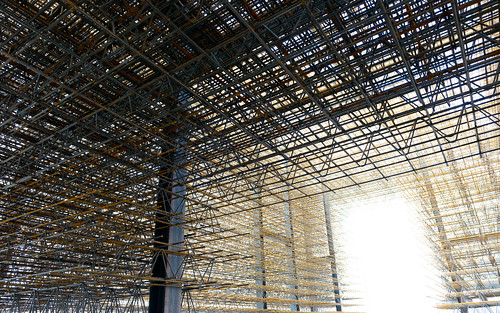---
Well, that seems a bit contrary to the essence of the last post about "slow revelation" of complex images: Shouldn't you arrive at a non-complex image if you "eliminate the nonessential"? Or to put it more positively: Shouldn't the concentration on the essential lead to simple(r) images that reveal themselves quickly? I simply find it hard in photography to shoot complex images that don't contain some nonessential parts.
And then there's also the question of what is nonessential! I discussed about a shot of a sculpture in front of a building: I had included a tourist taking a shot of the construct in my photograph and my wife didn't like it. She felt that the man was nonessential while I found that the inclusion of the photographer delivered (a) a sense of size and (b) was a nice contrast to the steel, concrete, and glass. But then I never really thought about what the image should convey.
But some minutes before I took a shot from within the structure that had no persons wandering around it and no building in the background (the New Museum in Nuremberg) and i must admit, that after a while it was the image that I was most fond of. I think it has no nonessential elements in it and is quite complex - at least regarding the number of lines in it. Interestingly all the lines follow some basic geometry so the sculpture in itself creates an example of how you can combine complexity and simplicity. The sculpture is called "Unschärfe" (unsharpness) and built from reinforcing steel by Matthias Loebermann & the Institute for architecture and ...
Hope you like it!

No comments:
Post a Comment